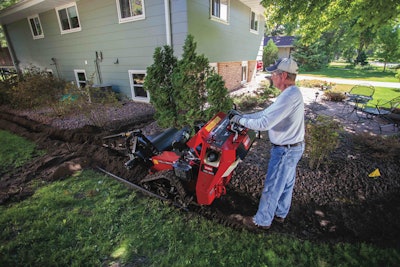 Photo: Toro
Photo: ToroThe accident: Using a walk-behind trencher, a landscaper checked the time by looking down at the cell phone attached to his belt. As he did so, the trencher’s digging device tilted toward a fence and its teeth made contact with the boards. The digging chain climbed the fence, tipping the machine up and backward. The worker was pinned between the overturned trencher and the ground. He suffered several broken ribs.
What the expert says: Stay away from fences and walls, the Association of Equipment Manufacturers’ Trencher Safety Manual warns. If the machine’s chain comes in contact with any vertical obstacle, an accident such as this can result.
Dropping a rapidly moving digging chain or wheel onto the ground is another dangerous mistake, according to the manual. The trencher can jerk forward if this occurs. A walk-behind operator could find himself chasing a runaway machine. “When starting a cut, set the digging boom or wheel down carefully and have the chain moving slowly,” the manual advises. “Leave adequate space for unexpected movement and be prepared to counteract device pull.” Check the manufacturer’s manual to find out how much space you should leave.
Because the digging chain auger or wheel is capable of throwing rock and soil debris a considerable distance, clear your work area of bystanders and other workers. Don’t risk a rollover when working on a hillside, the AEM manual cautions. Make sure you know the stability of the trencher and be aware vibration can make the machine slip sideways down a slope.
Avoid sharp turns while digging. Instead, turn gradually and carefully when the boom or wheel is down. If a sharp turn is required, begin a new cut from the old trench.
However, “use extreme caution when starting the new cut,” the AEM manual warns. “Know the soil conditions before starting. The weight of the machine may collapse the trench walls.”
In the event the machine jams, begins to labor excessively as it cuts or strikes something, shut it down and inspect it and the area. Never try to free a stuck chain or wheel while the trencher is running. Keep away from the exhaust pipe, muffler and hydraulic components. They will be hot after normal operation.
Before the machine even arrives at the jobsite, contact your local One-Call system so that utility companies can mark the locations of underground lines and cables. You can dial 811 from anywhere in the country and an operator will connect you with your local One-Call center. Be aware of the lead time for utility location in your area and don’t dig until all lines are marked.







